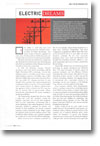
Electric Dreams
- Article 2 of 25
- Infoconomist, May 2001
Telcos and cable companies have a new competitor in the broadband Internet access market: the electricity companies.
Page 1 | Page 2 | All 2 Pages
The ability to send data and voice communications over electricity lines - so-called 'powerline networking' - has been a hallowed dream for electricity suppliers for many years. The promise is certainly compelling: everyone with access to an electricity supply could also have access to the Internet and voice services at local area network-like speeds, without additional lines needing to be installed.
The problems of delivering such data over the electricity network have, however, seemed almost insurmountable. Electricity networks are tuned for low frequencies and therefore low transmission rates; switching gear and electrical appliances produce frequent noise and interference bursts that swamp data.
Nevertheless, in 1997 UK electricity company Norweb announced that it had solved the problem with its Digital PowerLine (DPL) technology. Norweb had designed systems to condition power lines to accept higher frequency signals in the 1MHz range. It then devised conditioning units to direct data to and from the lines while still allowing electricity to pass through, as well as filtering unwanted signals and compensating for flaws in the line. This system, on its own, enabled voice communications. By adding a modem/router-like appliance to the customer's end of the system and connecting the transmission ends together using a network, DPL was also able to transmit data at approximately 1Mbps. Norweb even demonstrated the system working at speeds up to 10Mbps.
The shortcomings of DPL emerged later, however, when a larger trial went into operation. Among the problems uncovered was the fact that lampposts acted as radio transmitters, broadcasting data to anyone listening to the correct frequencies. Norweb eventually decided to abandon the project, not because of these problems, but because potential customers weren't interested in the 1Mbps system and wanted to hold out for a fully developed version of the 10Mbps system. That would have taken a further year to perfect: impatient for a return on its work, Norweb sold the technology to an undisclosed third party.
Others, however, have remained committed to the technology. In the US, for example, despite being hampered by a more basic electricity infrastructure and lower voltage rates, companies are still striving to find ways to link household devices to each other over home electricity networks. The dream is a world where homeowners can control their houses remotely, where burglar alarms can transmit warnings over the electricity system to whoever is listening. To this end, a consortium of companies, including 3Com, Cisco, Intel and Motorola, have founded the HomePlug Powerline Alliance, a non-profit organisation that aims to create a standard for the technology.
Meanwhile, Dallas-based Media Fusion has patented technology for gigabit networking over electricity lines, which takes advantage of esoteric aspects of quantum mechanics and the difference between alternating and direct currents. This allows two-way networking without the pair of cables required for ethernet networking. However, the company has yet to produce a proof of implementation of even a low-speed version of its technology and has just disposed of CEO William 'Luke' Stewart, who also developed the system.
Rival company Ambient, from Massachusetts, which is working on powerline networking system with ITRAN Communications of Israel, looks closer to commercial launch. It claims that its system will be ready for both low- and medium-voltage systems by mid-2002. It has funding from Wall Street investment firms like Oscar Capital Management LLC, Seneca Capital Management and the Pequot Group, and has been trialling the technology with Consolidated Edison Company of New York and Japan's Sumimoto. ITRAN, in turn, has just received funding from Microsoft for its home-networking products.
Europe could still be the early leader in this market, however. The potential for carrying data over electricity cables in Europe is greater because of the extensive use of national electricity grids, which reduces the frequency of power cuts as companies can re-route power if a particular segment of the grid fails. (What happens to data transmissions during power cuts is one of the big problems troubling US suppliers.) Another advantage for Europe is the greater number of households connected to individual transformer stations - approximately 300 to 400, compared to six or seven in the US. That drastically reduces the amount of equipment required to make powerline networking services operational.
Three European bodies to promote powerline networking standards and to help define regulation now exist - the PLCforum, ETSI and Cenelec. Currently, though, Europe's regulation of 'electromagnetic compatibility' is 100 times stricter than the US's, according to Peter Norman, president and CEO of nSine (see box). The US rules - set out by its regulatory body, the Federal Communications Commission (FCC) - are designed simply to minimise interference with AM radio broadcasts. The European rules, based on the international IEC CISPR-22 rules, are designed to limit any spurious emissions, no matter what the frequency.
The tight rein in Europe could hold back development of the market. Conversely, however, European companies will find it far easier to sell their powerline networking products in the US than vice versa - provided they build in compatibility. Paul Brown, chief executive at White Box Solutions, a UK-based consultancy specialising in powerline communications, says pressure is being put on the European regulatory bodies to relax their rules on electromagnetic compatibility. “The electrical utilities want to put more frequencies over their wires,” he explains. “There is a lot of work being done on the interpretation of CISPR-22.” Indeed, ETSI and Cenelec are both collaborating to set new standards for high bit-rate powerline technology.
Page 1 | Page 2 | All 2 Pages


